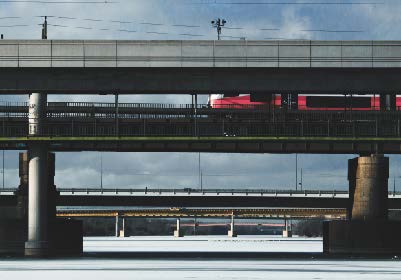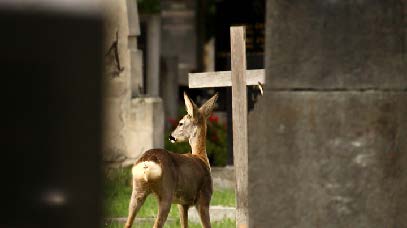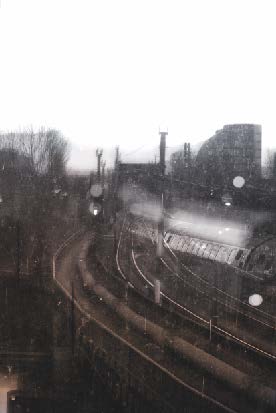By Marvin Alexander Heine
…I open up my eyes and see dozens of humans, young and old, in pleasurable selfindulgence deeply immersed in their phone. With a certain skepticism I watch a tastefully attained man, a father, holding his infant child. The child watches a shrill cartoon on one phone, while the man scrolls with his thumb over the display of a separate phone. This little instrument compartmentalizes, isolates and trains the perception of this defenseless creature. Smartphones bring everyone back to the safety of their home, the comfortzones, the satisfaction of online-shopping, fast-food-information, and simulated human connection(1). They are distant, objective facts, signifiers of a self-referential necessity, constantly transforming and conjuring by proudly proofing their own point. But most of all, these little, black objects that gently touch and smoothly caress the skin, – are hygienic, clean and sterile. Smell-less as they are, havens from the chaos of sensory information, they offer refuge and oblivion. Forget realism, – this is capitalist sensualism, – hyperaestheticized. I smell the disturbing taste of red-bull, deodorants, perfumes, textiles, a burger. I think someone just farted. This is life, teeming bare life. It is the same everydayness which is positioned as pathological above and below. So we let it fade away and replace it with an anosmic cube (2), white hygiene, offering a mesmerizing flow of information and disinformation to the sensorially deprived, culturally homogenized human of the 21. century, who’s subjective sensibility was cultivated and brought into being by the absent, the image, – by the disciplinary repetition of the mantra of commodity. We partake in the creation and approval of tautological, cannibalizing socio-economic virtualities, realms of products, self representation and immediately satisfiable desires. The train carriage empties, station by station. The rumbling and clattering of steel in motion gains fidelity, the noises reconfigure, I sense difference, grain, particularities. The rhythm smooths the thorns of noise.
Across from where I sit, a few seats further, facing me, garmented in a strikingly vivid Indian sari, I see a cheerful, beautiful woman, performing little dances, making funny faces and blowing kisses, dedicated to the little child in the baby stroller in front of her. The warmth and love she emanates is intense and radiates in pulses trough our train compartment. I have to smile and at one point I cannot hold it anymore and I laugh out loud. So here I sit, alone, dressed in a black hoodie. Next to me, not able to see the mother with her child, sits a young woman in my age, who’s attention I attracted. I feel her curious gaze on me, while I have to smile more and more broadly. When I look at her, from the corner of my eyes, I see an even, interesting face, revealing myriads of micro-expressions simultaneously. She reminds me of someone, – someone who makes me happy. Her eyes are filled with fire, almost blazing, – blue fire and pitch black lashes. There are only us four left in the carriage. The mother, her child, the woman next to me and me. The rhythms fade into each other. Like a Spanish guitar’s husky music. My whole body is filled with happiness, thanks to a mother’s play with her child. My feelings in turn contaminated the woman next to me, who is laughing too – and so here we are, transforming this space with solidarity and warmth. The air is sweeter, the colors brighter. This unexpected subversion of stereotypes, this theater of promise and desire for face-to-face contact, renders this space incomplete, in the making, let’s us script this place as it did script us before (3). New constellations of meaningful relations, new bodies of resonances, – a new rhythm, only for a short duration, and yet undeniably present, has been imprinted, echoing and reverberating into every corner of this space, this chaotic, smelly, noisy realm of the inbetween.

Everydayness, celebrated, in the constant process of becoming and transforming, creates moments of eurhythmia, alignment, potential and change. Of course, small encounters like these are necessary elements of the bigger rhythm, the rhythms of the state and of commodity and suffering. And yet, being surprised, being part of a hopeful improvisation among people, – sensing the poetics and potentialities of exchange, of micro-gestures, is a small revolution (4). All we need is, – more of it. Much more, – until this machine we’re sitting in, those networks, the whole city and every drunk, monk, dog and smartphone is infected by it, by an idea, the idea of creation and multiplicity, of decentering and diversity. I exit the Bridges in Spittelau, Vienna. 2019. Taken by the author train. I feel a little bit dizzy. I walk and walk, not knowing where to or why. But the sky seems brighter and the passerby’s faces seem more lively. Suddenly I realize that my path led me straight to a graveyard.
The air tastes like metal and mountain water. Where I am standing, with my eyes closed again, I am sensing and sniffing in the scents of fresh ploughed soil. It is quiet. I hear the wind playing in the trees, and every now and then there is a numb „donk“ when a chestnut hits the ground. I take a deep breath and open my eyes. I am standing in the center of an empty, wide square with seven narrow paths branching away from it. This area has the size of 2,5 km2, it is larger than two of Vienna’s districts combined and if one takes a closer look at the maps, it becomes obvious that this place is a labyrinth. This is the second largest Graveyard in Europe, designed by famous architects to give the dead a comfortable place to rot. They did a great job. I feel oddly alive and save, walking over the bones of three million viennese. „A schene Leich“. That’s what people use to say here. A good looking corpse. The people living in this city have the same morbid humor today as they had in 1874, when they dug up the earth to bury Jakob Zelzer, the first one among millions to be buried here. I take a look at the lighter in my hand: a giveaway-present, and in white letters it says „Bestattungen Wien“. I have to smile. I light up a cigarette and walk towards to setting sun in the west, which will probably lead me towards the buddhist cemetery, – and then the jewish cemetery. I really like it, that in this place the remains of human beings from every confession, culture, origin lie next to each other, laughing about the past and the present, and the ridiculous reasons the living bash their heads in over supposed ethnic and religious differences (5).
I enter a narrow pathway which is beautifully framed by an alley of glooming yellow and lilac autumn trees. The golden leaves that cover the ground crumble gently under the sole of my boots. There are 330.000 tombstones and at this moment every single one throws a growing shadow. The sun-cycle, and a thousand graves, – an enormous choreography, perfectly synchronized. In this charming city, – where the main problem in the summer time seems to be the question, if the subway-trains should be automatically aromatized with zitron-perfume (6), around 44 people are dying per day, – and 40 of them end up here, at the Wiener Zentralfriedhof, right beneath my feet. And that, my friend, is the bill. You have to pay 2,500 to 4,000 € to get disposed. But you had a whole life to work hard, spend your nights drinking and moaning, you deserve something better. Here, we have this beautiful shiny coffin for you for only a little extra-charge. No? You want to get cremated? We can do that! But if you want to take the urn home, we have to check in, and see if you placed the little casket in a delicate and solemn manner. What? No! That’s not a joke. That’s actually the law. A few days earlier, when I was having a tour through the central funeral building, I had the morbid pleasure to have a look into their „showroom“. You can get your remains bedded on the finest silk, or your ashes pressed into a diamond. When you are old you cannot work. You don’t earn money. You cannot spend it. You’re outside. They are making you invisible and hide you. And you are helping, because you are so damned ashamed to be useless. You are like one of those DELL laptops from 2007. A waste of resources. Redundant. Right until you made your last breath. Now, my friend, you are finally of value again (7). We throw a funeral-party for you, with the best wine from Niederösterreich. We buy a little sculpture of some divine person and take the second most expansive tombstone. My dear dead friend from Vienna, do you even realize how many jobs depend on you?

A strange sound awakens me from this imaginary dialogue. I am standing between two rows of graves, all of them overgrown with dark-red ivory. Behind one of them I see a pair of hooves disappearing. At first I don’t really believe it. I heard about the twenty deers living on this graveyard, but…Very slowly I place my feet on the gras, walking carefully closer, – and there is, in fact, a deer. The deer is eating the flowers from a grave. I like the attitude. Suddenly the deer is shaking it’s head very ambitiously and ends up looking at me. Behind a maria-statue a second deer appears. Hello Mr. and Mrs. Deer. After an awkward moment of silence8 these obscenely graceful creatures keep eating the flowers. I grew up wandering through forests and there was no deer daring to get so close to me. But in my forest they shoot deers on regular basis. On this graveyard no deer died since the mid-1980s. I follow them for over an hour. Every now and then a plane is flying extremely loudly over our heads. All three of us freeze when this happens. The Airport Schwechat, which was build seven decades after the Graveyard, is close. Thus, it is not allowed to let more than 14 balloons fly into the sky from these grounds. A graveyardguide told me that 15 balloons are enough to seriously confuse a pilot. That was a peculiar detail. I say thank you to my new friends and leave them be. I walk to the forest-graveyard, sit down on a tree-trunk, right next to a little burning candle. Everything around me looks like a forest clearing, – but looking closer I see a teddybear, little self-made boards with names written on them. For some reason it is not creepy. I light up a cigarette and watch people in the distance walking by. Then I see two young persons appear close to me. Every now and then they exchange a few sentences. They seem to be happy. They drink and smoke and lough and brood, and then they are investigating this tree, and then that plant. Explorers! Everyone, everything, our whole culture and economy rejects the notion of dying. They try to absorb it, to simulate it, to repress it. And here we are, on the grounds where so many people are buried, joyfully taking dying for granted, in the middle of a city, surrounded by highways, fiber-glass-cables, invisible communication-networks, by water and subways-trains, emergency response systems, advertisement-jingles, – and ghosts. (This was part two of a two part essay. Part one was published on this blog last week.)
Marvin Alexander Heine is a master student at the department of sociology at the University of Vienna. He is deeply interested in the senses, their phenomenology, mediations, and politics. Currently he is writing and filming his master thesis about the influence of the urban acoustics on processes of socialization.
Notes
(1) Amin & Thrift argue, that „the everyday rhythms of domesticate life have rarely counted as part of the urban, as though the city stopped at the doorstep of the home. But domesticate life is now woven routinely into the urban ‚public realm‘. How else are we to interpret the rise of home-working and teleshopping, and ‚public‘ involvement through the consumptiopn of goods, television, the internet and the growing exposure of domesticate life in chat shows (…)“. (Amin & Thrift 2002: p. 18)
(2) The Anosmic Cube, as it is articulated by Drobnick: „(…) smooth surfaces and geometric perfection point not inly to an intolerance of the olfactory, but to a distrust of the organic, of the sensual, of anything alluding to the realities and controversies of the external world.“ (Drobnick, 2005: p. 267)
(3) Blok & Farias argue, that „the urban built environment has been cast as a text that is written and read by different urban actors in different ways“. (Blok & Farias 2016: p.568)
(4) Lefebvre argues, that „by fully reinstating the sensible in consciousnesses and in thought, he (the rhythmanalyst) would accomplish a tiny part of the revolutionary transformation of this world and this society in decline.“ (Lefebvre 1992: p. 26)
(5) For more information on the escalation that happened upon the opening of Zentralfriedhof in Vienna see Bauer (2004)
(6) For more information on spraying incense into Vienna’s subway carriages see Walker (2019)
(7) „Violent death changes everything, slow death changes nothing, for there is a rhythm, a scansion necessary to symbolic exchange: something has to be given in the same movement and following the same rhythm, otherwise there is no reciprocity and it is quite simply not given. The strategy of the system of power is to displace the time of the exchange, substituting continuity and mortal linearity for the immediate retaliation of death. It is thus futile for the slave (the worker) to give little by little, in infinitesimal doses, to the rope of labour on which he is hung to death, to give his life to the master or to capital, for this ‘sacrifice’ in small doses is no longer a sacrifice it doesn’t touch the most important thing, the différance of death, and merely distils a process whose
structure remains the same.“ (Baudrillard 1993: p. 71)
(8) „The animal looks at us, and we are naked before it. Thinking perhaps begins here.“ (Derrida 2006: p. 29)
Bibliography
Amin, A., & Thrift, N. (2002). Introduction & The Legibility of the Everyday City. In Cities: Reimagining the Urban (pp. 1-30). Cambridge: Polity.
Baudrillard, J. (1993). Symbolic Exchange And Death. Sage: London.
Bauer, W. (2004). Wiener Friedhofsführer: Genaue Beschreibung sämtlicher Begräbnisstätten nebst einer Geschichte des Wiener Bestattungswesens (Kultur für Genießer). Wien: Falter Verlag.
Derrida, J. (2006). The Animal That Therefore I am. New York: Fordham University Press.
Drobnick, J. (2002). Volatile Architectures. XYZ Books, Toronto.
Farias, I. & Blok, A. (2016). STS in the City. In C. Miller, et al. (Eds.), Handbook of Science and Technology Studies (4th Edition, pp. 555-582). Cambridge MA: MIT Press.
Lefebvre, H. (1992). Rhythmanalysis. London: Bloomsbury.
Walker, S. (2019). Passengers incensed: Vienna adds perfumed trains to €1 a day travel. https://www.theguardian.com/world/2019/jul/19/vienna-trials-perfumedsubway-
trains-passengers-incensed-austria-u-bahn

